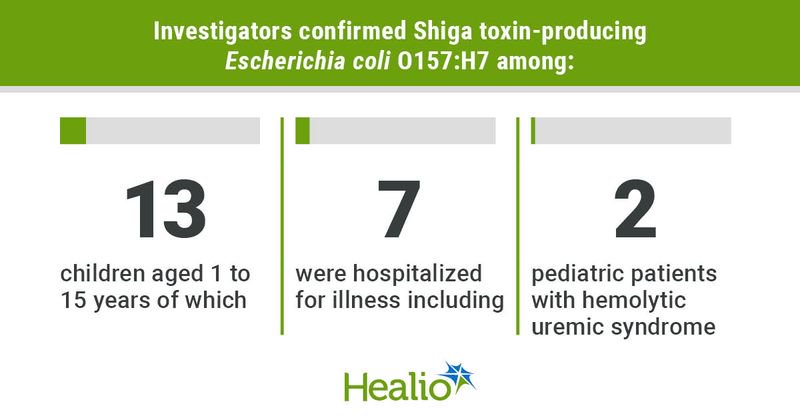Untreated irrigation water linked to 2023 E. coli outbreak among 13 Utah children
Key takeaways:
- Most patients were exposed to untreated, pressurized, municipal irrigation water the week before symptom onset.
- Shiga toxin-producing E. coli O157:H7 was isolated from reservoir sediment and water samples.
A 2023 outbreak of Shiga toxin-producing Escherichia coli O157:H7 involving at least 13 children in Utah was linked to untreated municipal irrigation water, according to a CDC investigation published in Morbidity and Mortality Weekly Report.
“Shiga toxin-producing Escherichia coli (STEC) O157:H7 is an enteric illness that can cause hemolytic uremic syndrome (HUS), a severe, life-threatening condition which affects the kidneys,” BreAnne Osborn, MPH, of the Utah Department of Health and Human Services, and colleagues wrote. “Young children, aged younger than 5 years, are among the most susceptible to HUS.”

From July 25 to 30, 2023, six cases of STEC 0157:H7 in children, all of whom lived in the same city, were reported to the Utah County Health Department. Following preliminary whole genome sequencing, investigators determined that clinical isolates from two infected children were identical, and a full investigation was launched July 31.
Investigators confirmed STEC O157:H7 among 13 children aged 1 to 15 years (median age, 4 years), with illness onset between July 22 and Aug. 31. Of those, seven were hospitalized, including two patients with HUS, but no deaths were reported.
Results of a questionnaire showed that 12 patients were exposed to untreated, pressurized, municipal irrigation water the week before symptom onset, which included playing with hose water, inflatable lawn water toys, water tables, drinking and running through sprinklers.
In an environmental investigation, researchers collected water and sediment samples from two of the city’s reservoirs as well as nine confirmed exposure sites for culture of STEC O157:H7 and whole genome sequencing of confirmed isolates. They also tested grab-water samples for generic E. coli and total coliforms per 100 mL. In addition, clinical labs submitted stool samples from infected patients for culture, isolation and sequencing.
Researchers isolated STEC O157:H7 from reservoir sediment and dead-end ultrafiltration water samples at five of the nine exposure sites, but it was not found in any other environmental samples.
In light of the outbreak, the Utah County Health Department warned residents against drinking or playing in untreated, pressurized, municipal irrigation drinking water, but after two additional cases were reported, they also advised the public to cook homegrown produce and avoid watering lawns.
“This outbreak demonstrates the need for ongoing educational efforts and reminders,” Osborn and colleagues wrote. “Educating residents of communities with untreated, pressurized, municipal irrigation water systems, especially those at higher risk for severe illness about the importance of using untreated, pressurized, municipal irrigation water for its intended purposes as well as the risks associated with drinking and recreational exposure, could prevent future cases of untreated, pressurized, municipal irrigation water-associated waterborne illness.”
